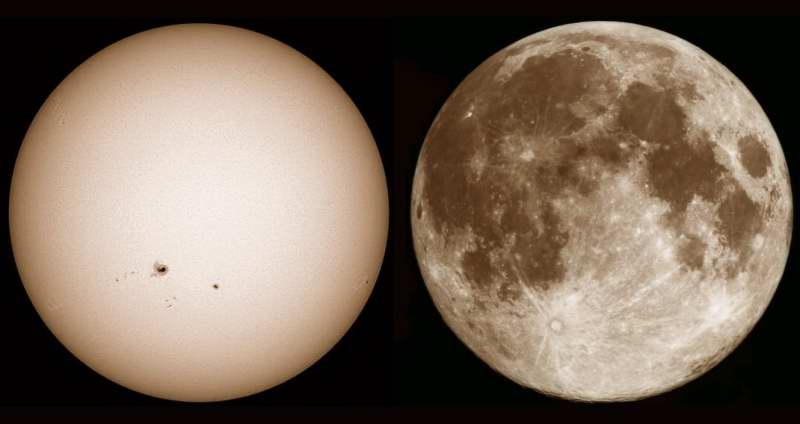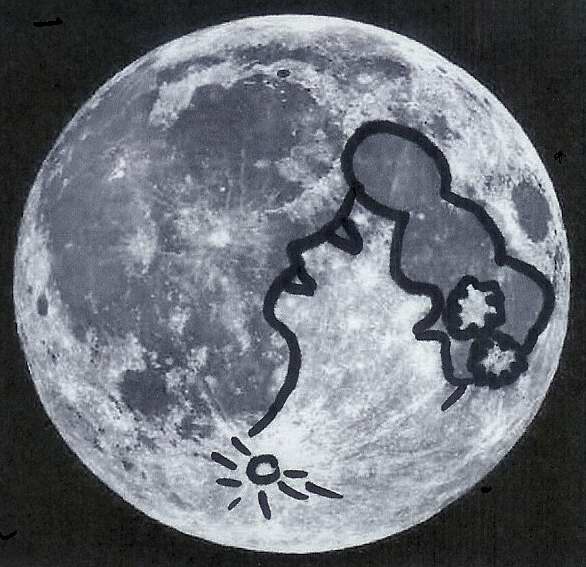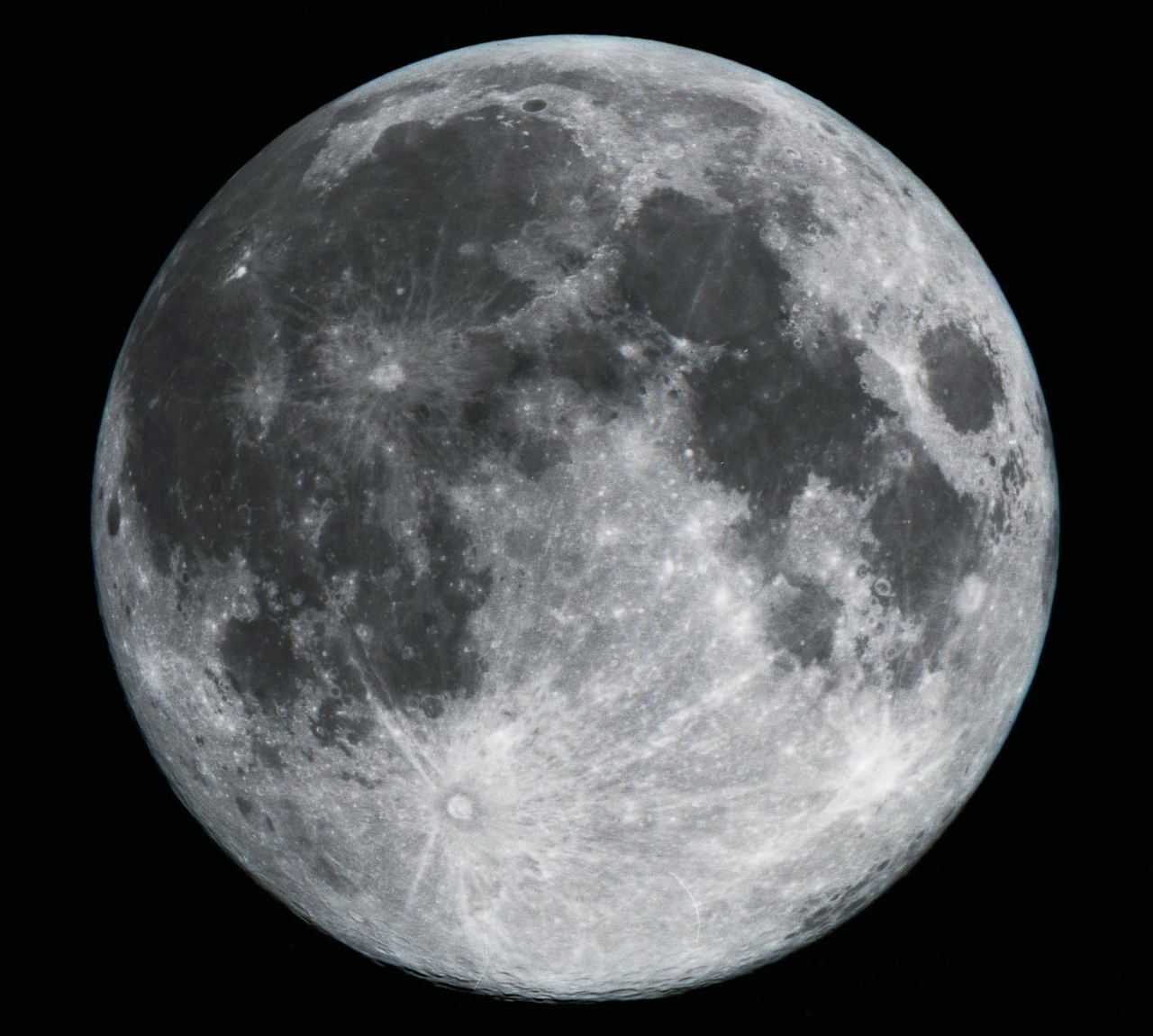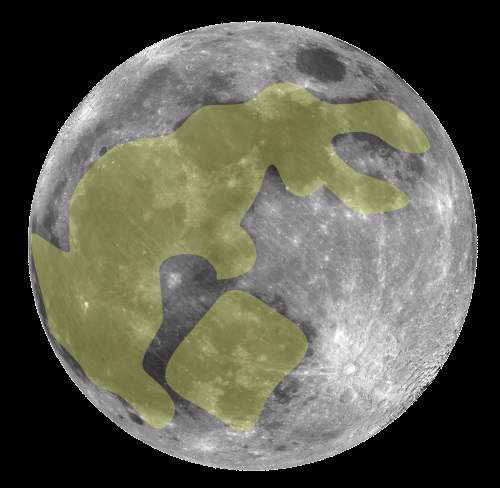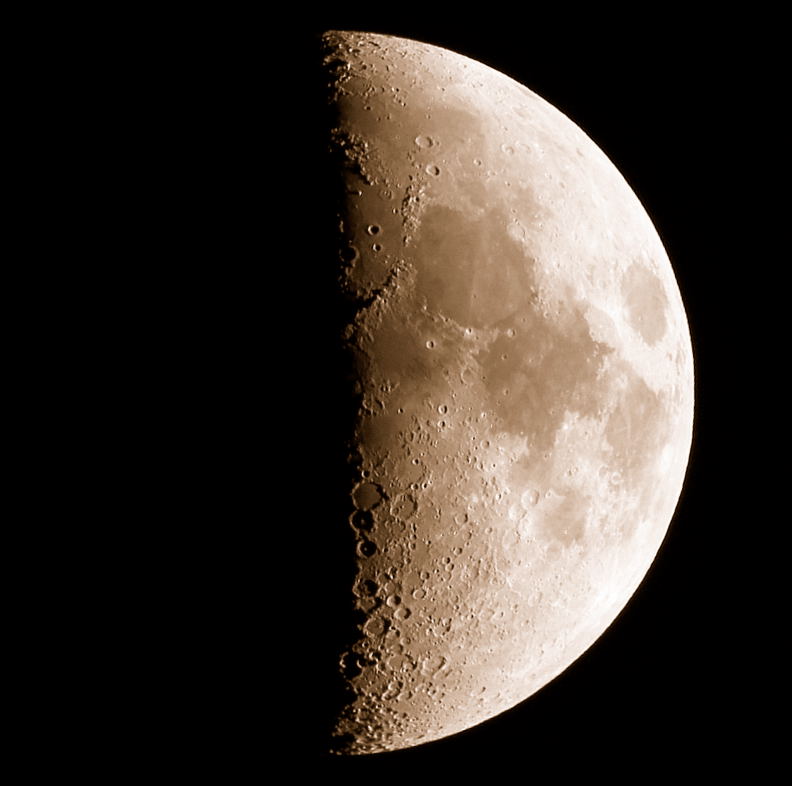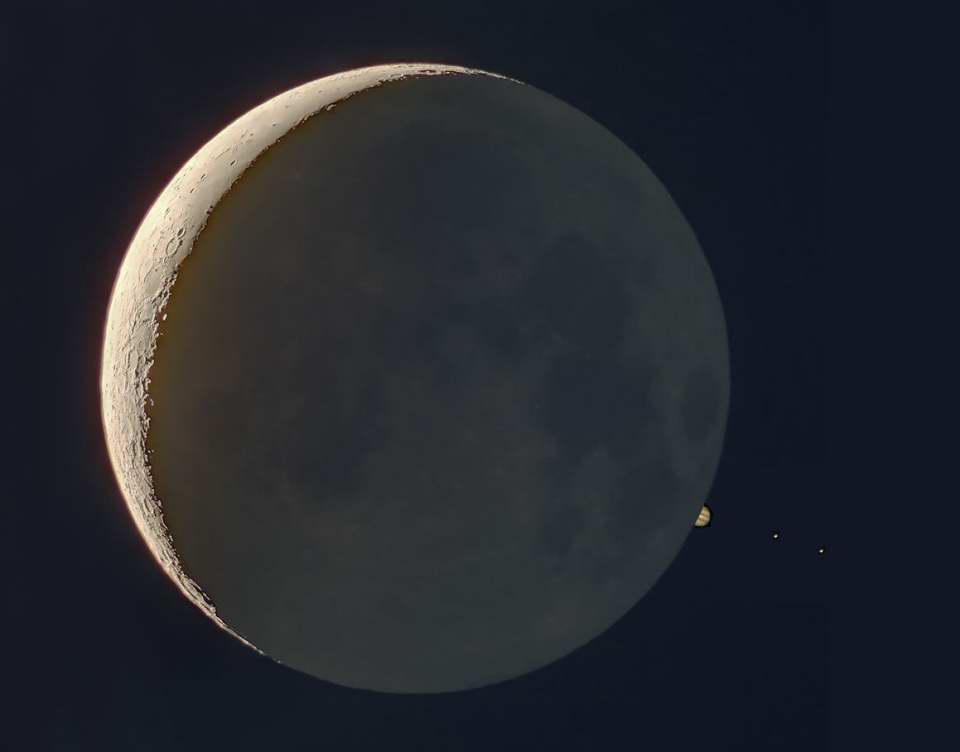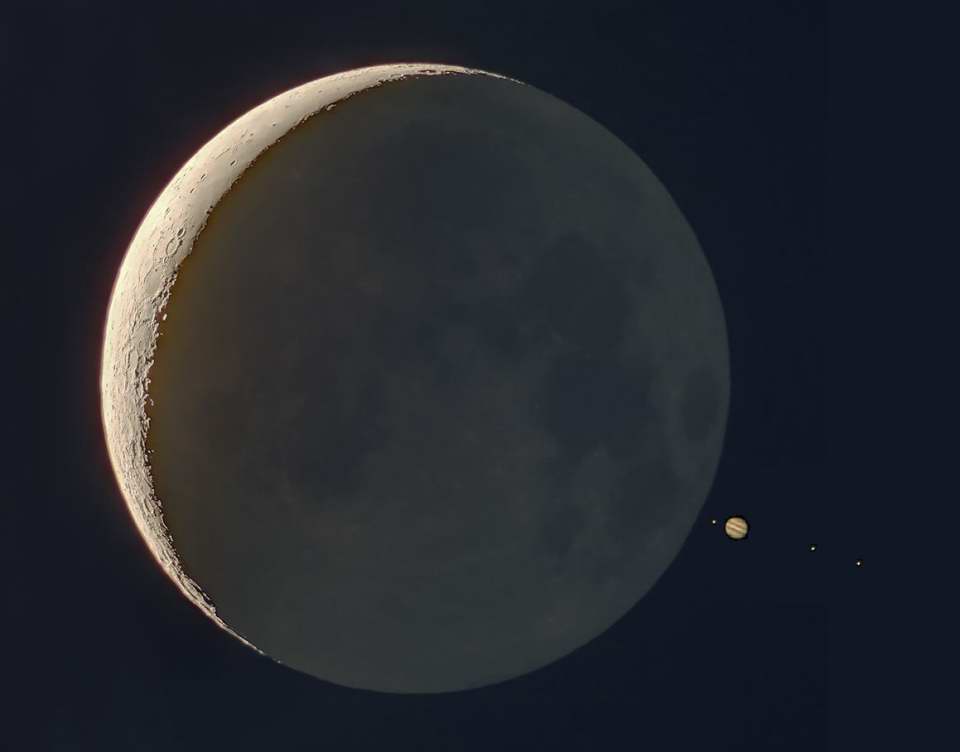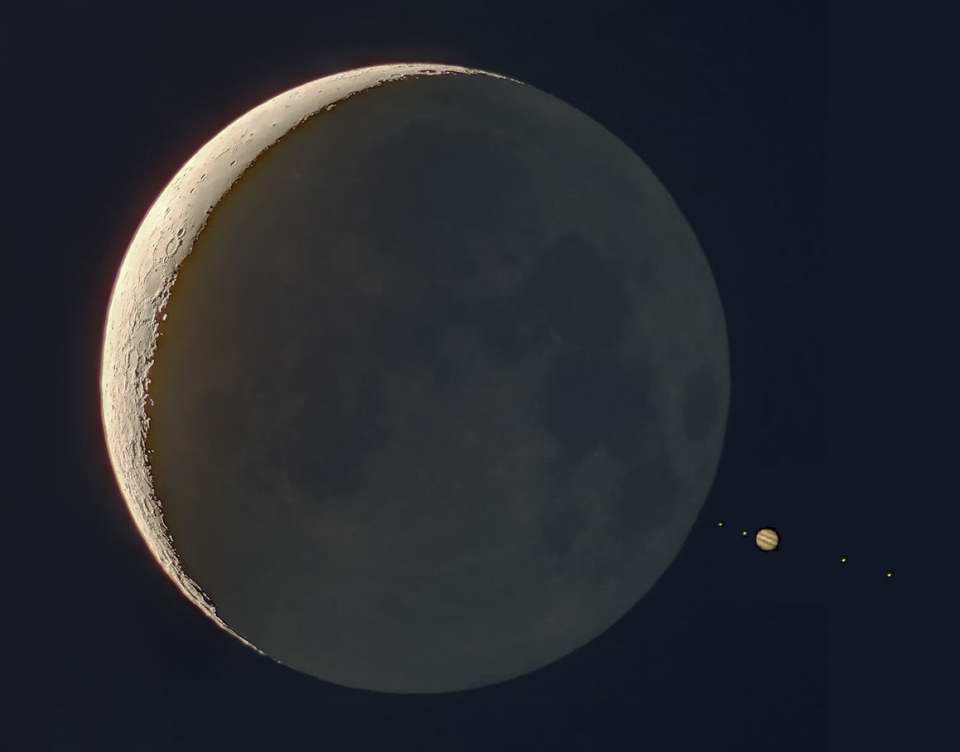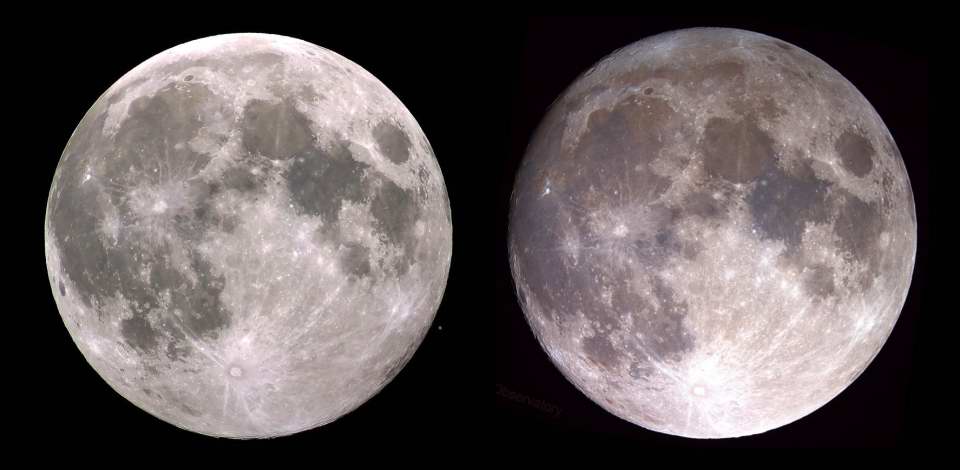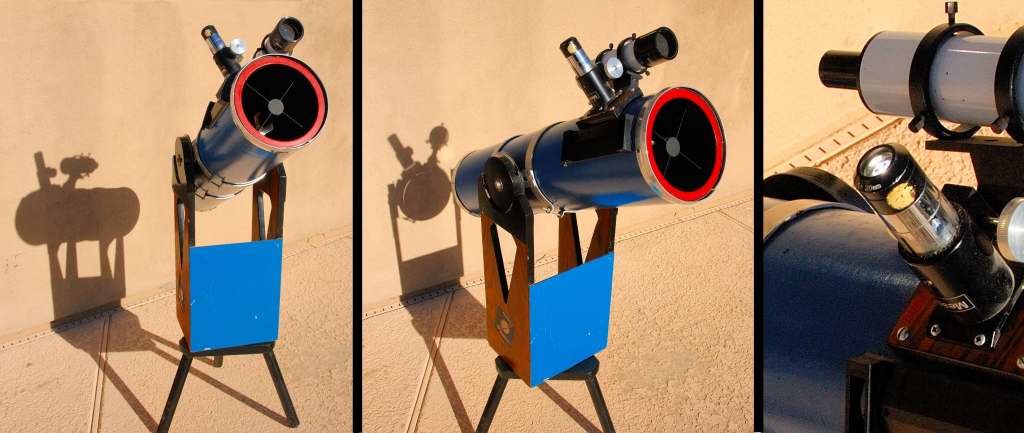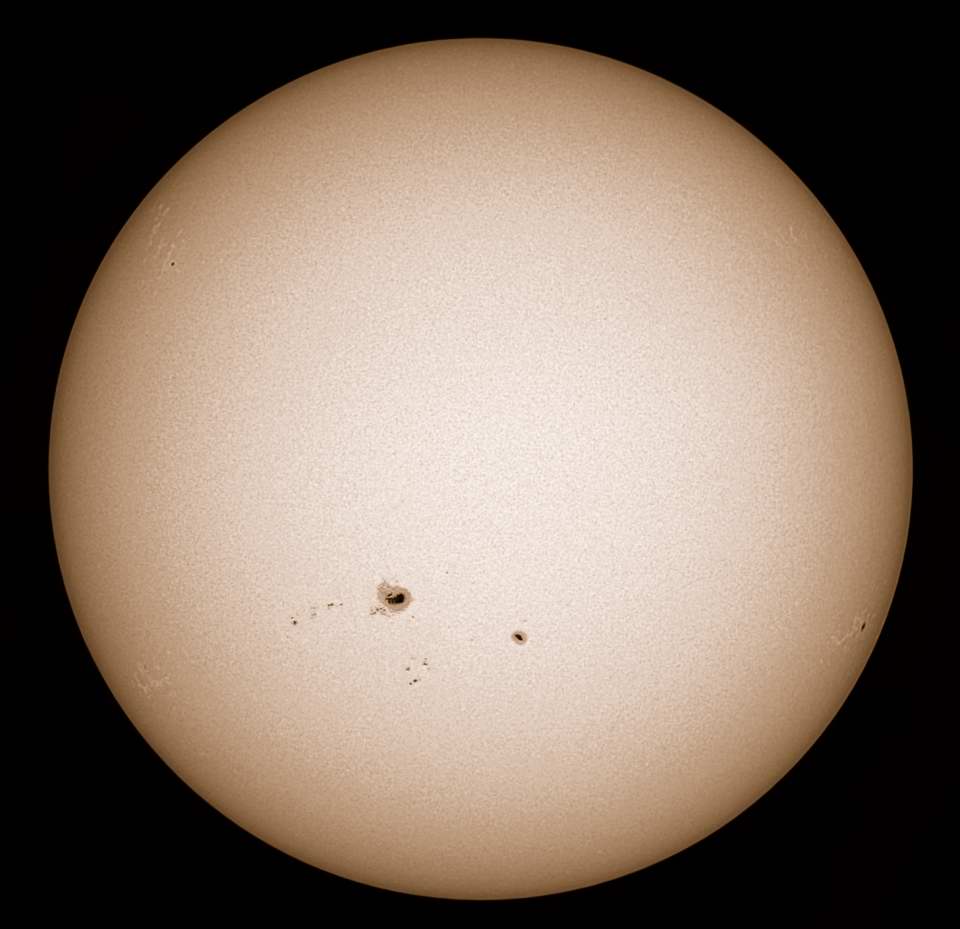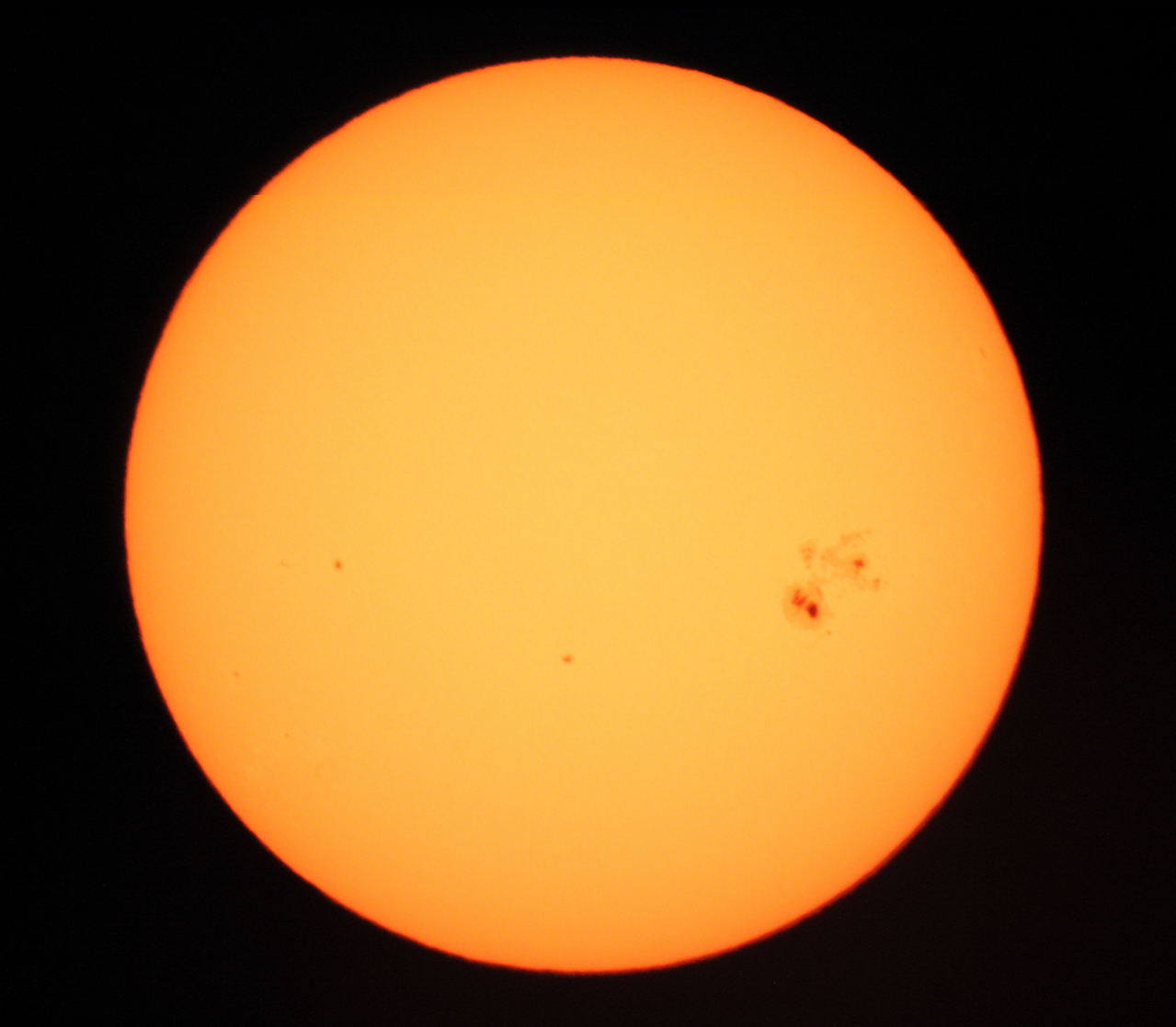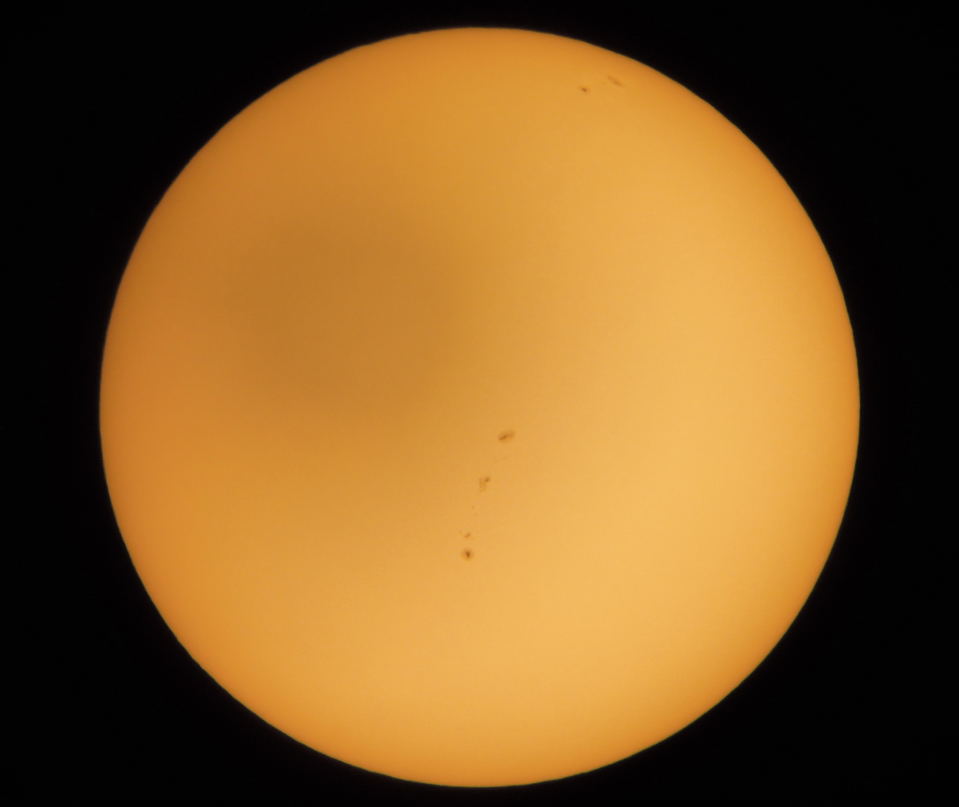Beginner's Guide
Solar System - Sun and Moon
The Sun and Moon
The Sun and the Moon are the big showcase objects in the sky. The apparent sizes are so large (about a ½° in diameter), you can easily see the discs with the naked-eye. By a complete coincidence the apparent sizes are nearly the same. Even though the Sun is about 400 times larger than the Moon, it is also about 400 times farther away. And unlike every other object the viewing is not harmed by light pollution so they can be seen equally well anywhere.
Moon
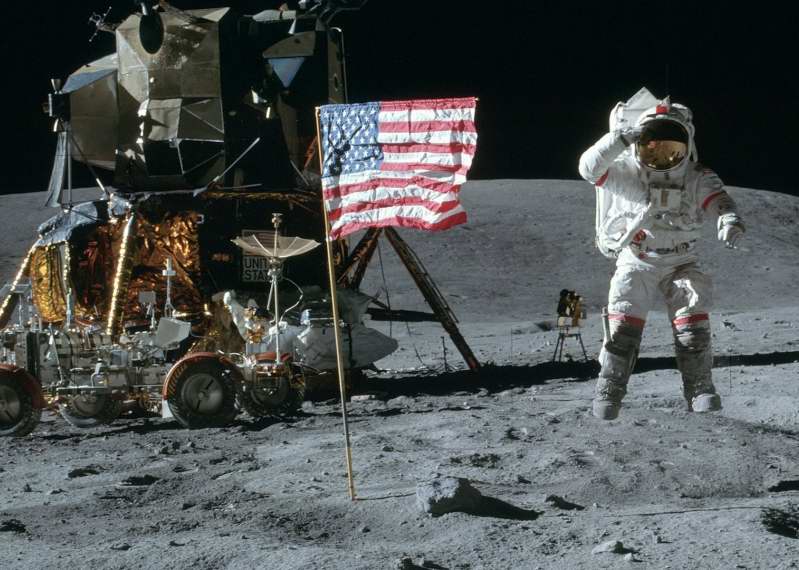 The moon is by far the largest object in the night sky. You can see detail just by naked-eye viewing, although the craters cannot be seen. For that
all you need is binoculars. And in a telescope, it's simply awesome. The moon is also the brightest object in the night sky which has a big
downside: it will wash out the sky and make observing deep space objects difficult to both find and see. But there's little you can do about that
other than simply observe when the moon is either not in the sky, or just a thin crescent when it isn't so bright.
The moon is by far the largest object in the night sky. You can see detail just by naked-eye viewing, although the craters cannot be seen. For that
all you need is binoculars. And in a telescope, it's simply awesome. The moon is also the brightest object in the night sky which has a big
downside: it will wash out the sky and make observing deep space objects difficult to both find and see. But there's little you can do about that
other than simply observe when the moon is either not in the sky, or just a thin crescent when it isn't so bright.
The moon has inspired owe throughout the ages, but since 1969 we now view it with the knowledge that man has walked on its surface.
Lunar Phases
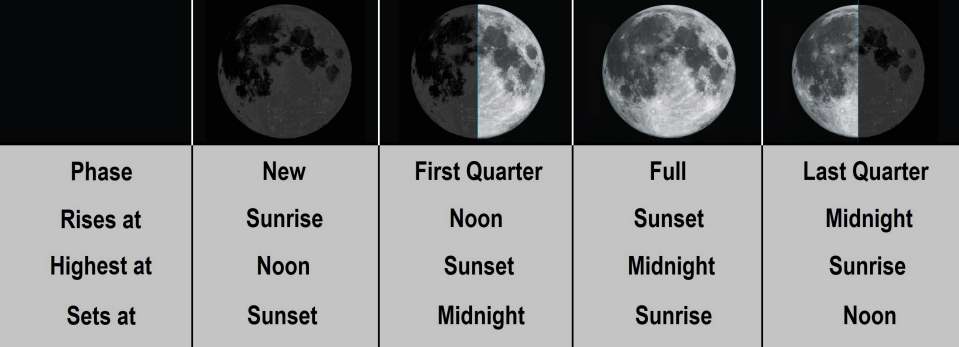
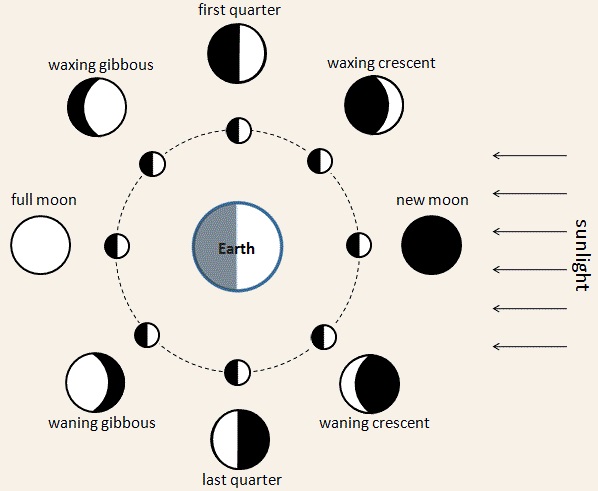 The diagram above shows the major lunar phases.
But we also recognize 4 additional phases between those. So the 8 phases are New, Waxing Crescent,
First Quarter, Waxing Gibbous, Full, Waning Gibbous, Last Quarter, Waning Crescent, and back to New. These 8 phases
are shown in the diagram at the right that shows why these phases occur.
The diagram above shows the major lunar phases.
But we also recognize 4 additional phases between those. So the 8 phases are New, Waxing Crescent,
First Quarter, Waxing Gibbous, Full, Waning Gibbous, Last Quarter, Waning Crescent, and back to New. These 8 phases
are shown in the diagram at the right that shows why these phases occur.
The moon revolves around the Earth once every 27.32 days. But that revolution relative to sun is 29.53 days. So Full Moon to Full Moon is that 29.53 days.
Naked-Eye and Binoculars
With the naked-eye you can see dark and light areas. The dark areas are the lunar maria (Latin for seas) and the light areas are the mountains and craters.
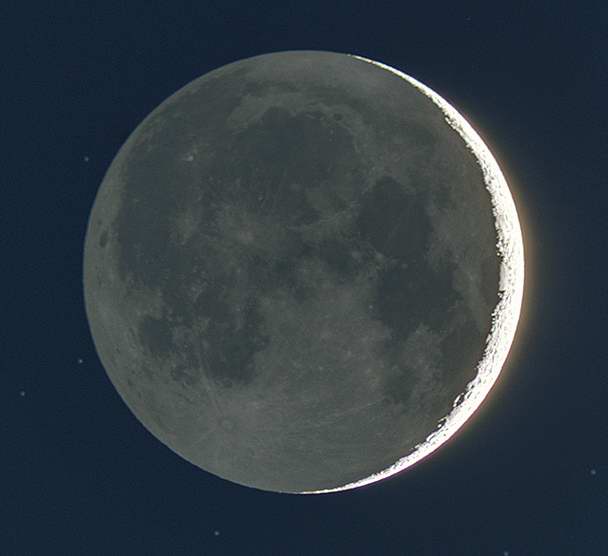 When the moon is in its crescent phases (waxing and waning), features in the dark area are visible. This is called Earthshine because the
source of the lighting comes from our planet. If you imagine yourself on the moon in that dark area, the Earth is the sky and it's at a relatively
full phase to it would be brilliant in the moon sky! As seen from the Moon, the Earth goes through the same phases as the moon.
When the moon is in its crescent phases (waxing and waning), features in the dark area are visible. This is called Earthshine because the
source of the lighting comes from our planet. If you imagine yourself on the moon in that dark area, the Earth is the sky and it's at a relatively
full phase to it would be brilliant in the moon sky! As seen from the Moon, the Earth goes through the same phases as the moon.
In a Telescope
The moon in a telescope is as good as you see in the photographs. No other astronomical object is like that. And it's easy to locate. You don't really even need your finderscope or GOTO system: just point in the general vicinity and look around in the eyepiece. When it's getting bright you know you're getting close. And though the view isn't great, you can see it during the daylight.
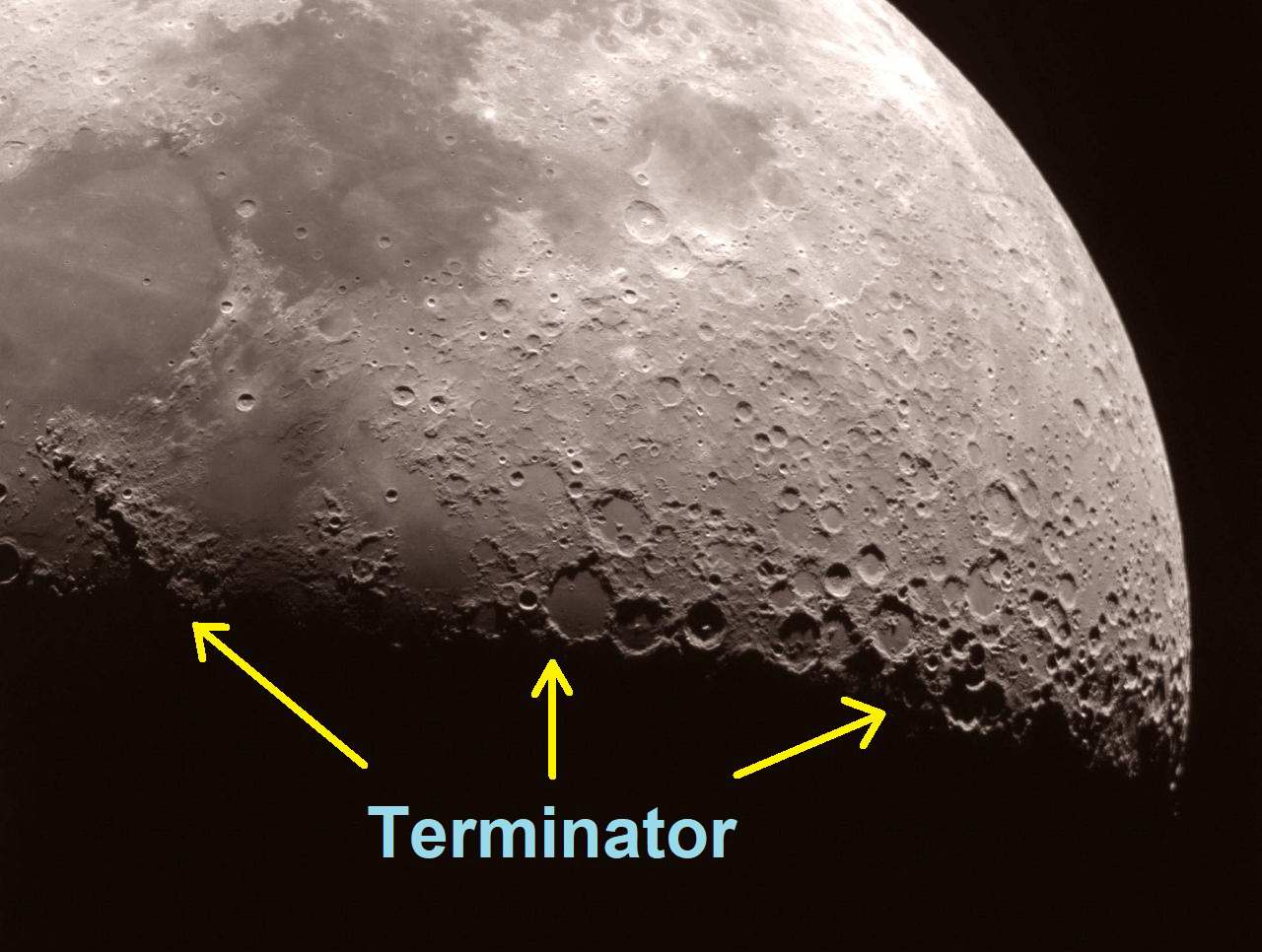 When is the best time to view the moon?
To a beginner that sounds like a trick question! Of course, the full moon. But if you look carefully at
the full moon picture above you should notice the absence of craters that are visible in the picture of the first quarter.
The image at the left shows the lunar terminator. This is the dividing
line between night and day on the Moon. This is where you can see the
craters. The further from the terminator line, the craters are not as
clear. Why? Even though a crater's walls may be 2 miles high, that's
insignificant at the moon's distance of nearly 250,000 miles so it's
makes sense that it would be nearly impossible to see. But along the
terminator line the sun is very low in the sky so the shadows cast are
very long which increases the contrast and makes them more visible.
When is the best time to view the moon?
To a beginner that sounds like a trick question! Of course, the full moon. But if you look carefully at
the full moon picture above you should notice the absence of craters that are visible in the picture of the first quarter.
The image at the left shows the lunar terminator. This is the dividing
line between night and day on the Moon. This is where you can see the
craters. The further from the terminator line, the craters are not as
clear. Why? Even though a crater's walls may be 2 miles high, that's
insignificant at the moon's distance of nearly 250,000 miles so it's
makes sense that it would be nearly impossible to see. But along the
terminator line the sun is very low in the sky so the shadows cast are
very long which increases the contrast and makes them more visible.
The position of the terminator is therefore paramount in lunar observing. There are two intervals during the lunar cycle (one New Moon to the next) which are the good for observers. The first begins shortly after a New Moon and continues until about two days after the First Quarter. On these nights, the Moon lies in the early evening sky. The second interval starts about two days before the Last Quarter and ends shortly before the New Moon. On those nights, your viewing will need to be after midnight.
Features
 When you look at the moon with the naked-eye, you see bright and dark areas. The bright areas are the mountains, valleys, and craters. The dark
areas are the relatively flat areas. These are the "water" areas. Of course we now know there is no water, but you can easily understand
why the ancients thought this. And you need to know this to understand how they named those features. They used Latin names so you have
Maria (Seas), Oceanus (Oceans), Lacus (Lakes), Sinus (Bays), and Palus (Marsh). For the bright areas they're labeled as Craters (no Latin name),
Catenae (Chain of Craters), Vallis (Valleys), Mons (Mountains), and Montes (Mountain Ranges).
When you look at the moon with the naked-eye, you see bright and dark areas. The bright areas are the mountains, valleys, and craters. The dark
areas are the relatively flat areas. These are the "water" areas. Of course we now know there is no water, but you can easily understand
why the ancients thought this. And you need to know this to understand how they named those features. They used Latin names so you have
Maria (Seas), Oceanus (Oceans), Lacus (Lakes), Sinus (Bays), and Palus (Marsh). For the bright areas they're labeled as Craters (no Latin name),
Catenae (Chain of Craters), Vallis (Valleys), Mons (Mountains), and Montes (Mountain Ranges).
But these are not the only ones. For a more complete list, here is a link to the Wikipedia entry for a List of Lunar Features.
Supermoon
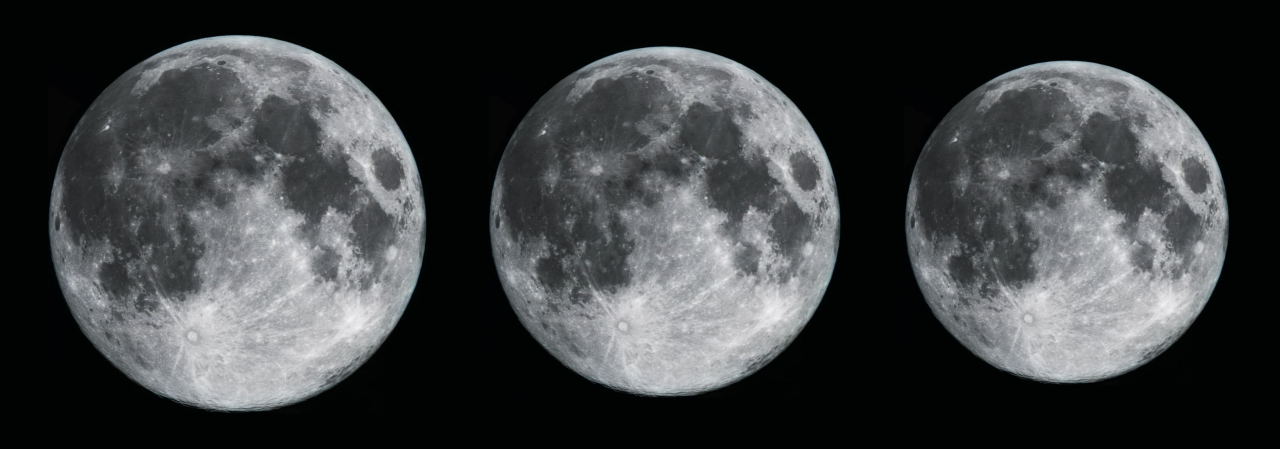
The moon's apparent size varies as it orbits the Earth because that orbit is actually an ellipse and not a perfect circle. The moon is not unique in this aspect as every planet and moon orbit in our solar system is an ellipse. It's not that a circle isn't possible, but the odds are so low it can be considered an impossibility.
As you can see from the diagram (not to scale), the moon's distance from the Earth varies between about 363,000km to 405,000km. A Supermoon occurs when the full moon happens when the moon is at or near the perigee. A moon is considered "super" when it's distance is at least 90% of the perigee distance. At the other end (which does not get a lot of press) is the Micromoon. That's when it's a full moon within 90% of the apogee distance.
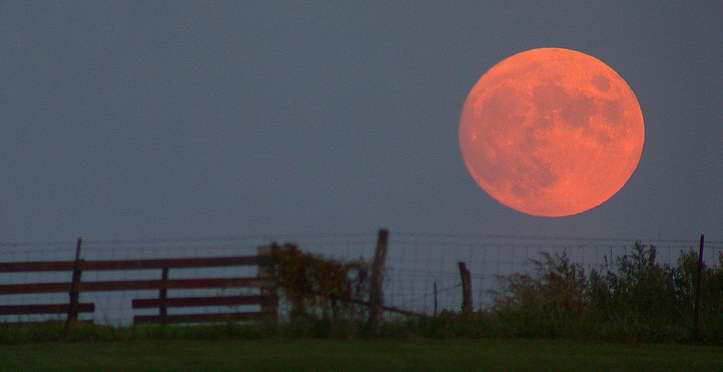 Unfortunately, neither the Supermoon or the Micromoon are good visual events as it's difficult to impossible to tell
just by looking. So though much
is made of the Supermoons, they don't live up to the hype, at least to an astronomer. But this is not usually the case with the general public.
At the time of the full moon, it rises as the sun sets so at a time when everyone is awake and the moon will be low on the eastern horizon. The moon seen
near the horizon can appear nearly 50% larger than it does when it's directly overhead. This is called the
moon illusion and it is entirely an optical
illusion. So the general public will probably think it's because of the Supermoon.
Unfortunately, neither the Supermoon or the Micromoon are good visual events as it's difficult to impossible to tell
just by looking. So though much
is made of the Supermoons, they don't live up to the hype, at least to an astronomer. But this is not usually the case with the general public.
At the time of the full moon, it rises as the sun sets so at a time when everyone is awake and the moon will be low on the eastern horizon. The moon seen
near the horizon can appear nearly 50% larger than it does when it's directly overhead. This is called the
moon illusion and it is entirely an optical
illusion. So the general public will probably think it's because of the Supermoon.
Two effects that are not an illusion is the flattened moon and the reddish / orangish moon. The flattened moon is caused by refraction. The reddish / orangish moon is caused by the light having a longer path through the atmosphere and the red rays penetrate more easily. Both of these effects also apply to the sun.
Lunar Occultations
From time to time the moon passes in front of a star or planet hiding it for a while. This is called an occultation. There are two types of occultations: bright limb and dark limb. A dark limb occultation is far more striking that a bright limb because of the contrast. If it's a star the view is suddenly seeing that star disappear or reappear.
The following three images show a dark limb occultation of Jupiter and its 4 Galilean moons as it reappears as the occultation ends.
The best way to find out about upcoming occultations is through Sky & Telescope and Astronomy Magazines websites.
Sky & Telescopes: This Week's Sky At a Glance
Astronomy: The Sky this Week
Lunar Libration
Once you are even somewhat familiar with the features of the moon you'll notice that the appearance of the moon always seems the same. The explanation is fairly easy: the rotation rate of the moon around its axis is exactly the same as the lunar month (i.e., the time between the same phases like the full moon). But exactly? The time between full moons is 29.53 days. If the moons rotation rate was even one minute off, over time we would observe that our view of the moon was slightly rotating. But that has not been the case. This cannot be coincidence. The reason is tidal locking.
Though this should mean we only see 50% of the moon's surface, we actually can see up to 59% of the surface due to lunar libration. From our vantage point on Earth the moon seems to slowly rock both back/forth and up/down. The various mechanisms that cause this are out of the scope of our beginner's guide, but we mention it because you can observe it!
The photos of the full moon above were taken by two members of the Milwaukee Astronomical Society. You should be able to see the orientation differences by focusing on specific lunar features and their position differences.
Lunar Eclipses
We have an entire web page to discuss lunar eclipses. Click/tap here to go to that page.
Sun
| Warning: Observing the Sun is dangerous! |
It is our obligation and it's advisable to let people know the inherent danger in trying to observe the sun. First, you should never look directly at the Sun with your eyes or even sunglasses. The same thing goes for binoculars and telescopes.
But it can be done (cautiously) with the use of specialized commercial filters.
Projection
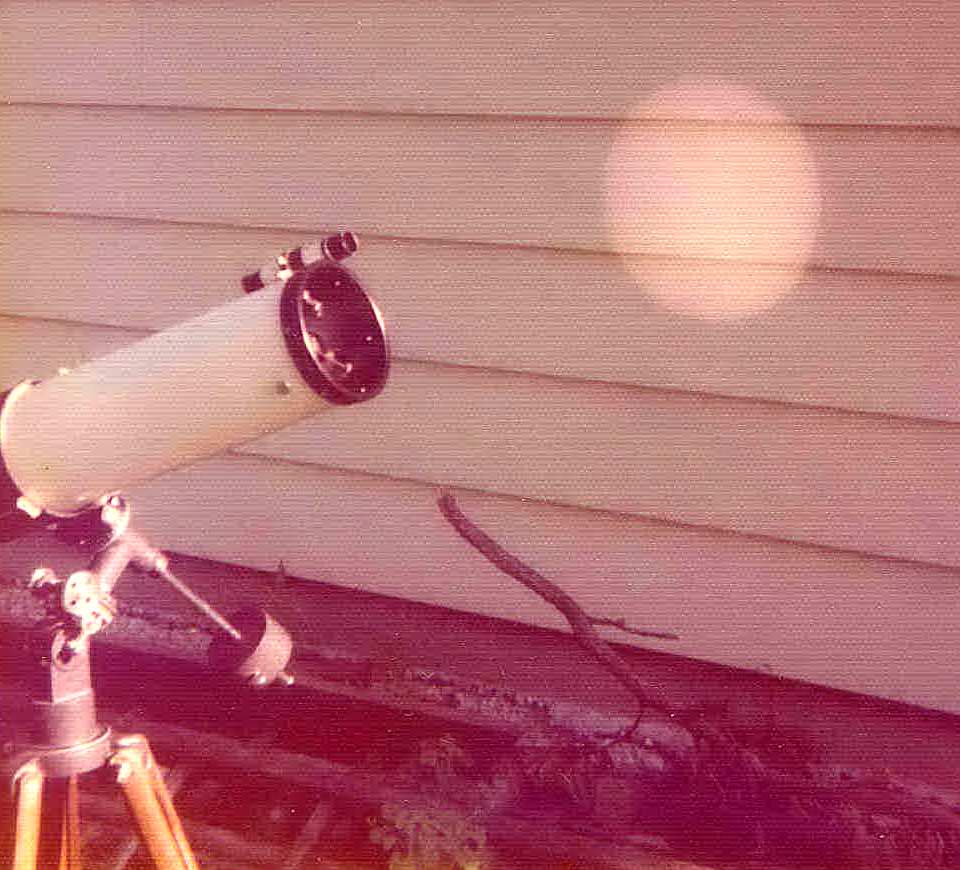 There is, however,
a safe way to view the sun with a telescope: projection. But when we say this, we're talking about preserving your sight. For telescopes of 10-inch
aperture or more, the heat generated by the sun can literally burn the inside of your telescope! This is not to say you can't use a larger telescope
for solar projection, but you need to use an aperture mask (i.e., effectively making the telescope a smaller aperture.) After all, the sun is plenty
bright so any loss of light is insignificant.
There is, however,
a safe way to view the sun with a telescope: projection. But when we say this, we're talking about preserving your sight. For telescopes of 10-inch
aperture or more, the heat generated by the sun can literally burn the inside of your telescope! This is not to say you can't use a larger telescope
for solar projection, but you need to use an aperture mask (i.e., effectively making the telescope a smaller aperture.) After all, the sun is plenty
bright so any loss of light is insignificant.
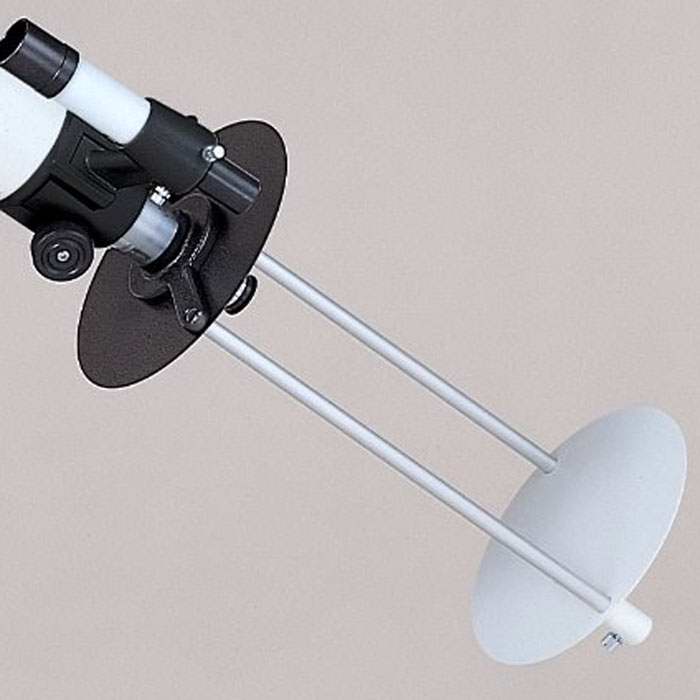 Projection can be as easy as just using a sheet of white paper, but it far better to use a white piece of cardboard because it's more rigid. How far
do you hold the cardboard screen from the eyepiece? That it strictly your preference. The image grows dimmer as you move the screen further away. So you
simply decide where there is a good balance between brightness and the ability to see sunspots. But odds are the image will not be in focus. All
you need to do is use your focuser for that adjustment. But there are some commercial products available for solar projection.
Projection can be as easy as just using a sheet of white paper, but it far better to use a white piece of cardboard because it's more rigid. How far
do you hold the cardboard screen from the eyepiece? That it strictly your preference. The image grows dimmer as you move the screen further away. So you
simply decide where there is a good balance between brightness and the ability to see sunspots. But odds are the image will not be in focus. All
you need to do is use your focuser for that adjustment. But there are some commercial products available for solar projection.
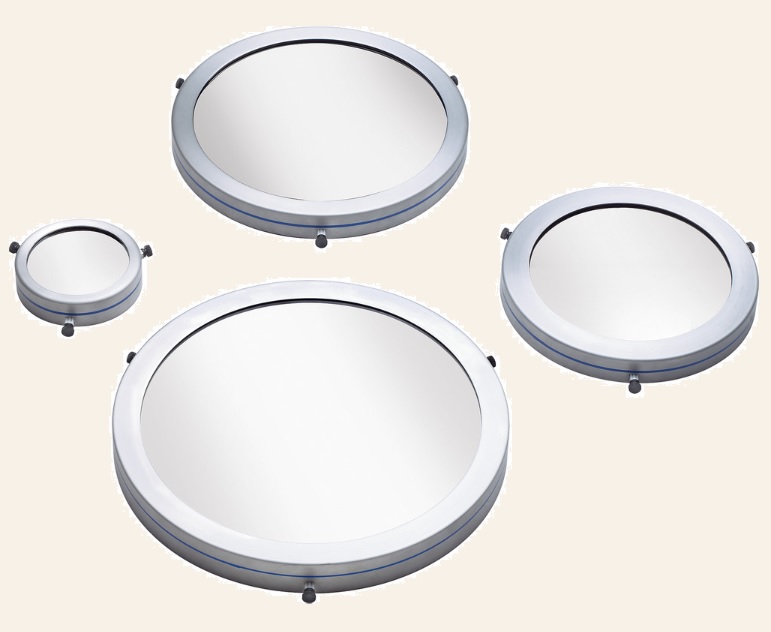
Direct Viewing
Though projection is adequate, you'll get a better view if you get a commercial solar filter that fits at the end of your telescope tube. The reason this is so much safer is the intense light and heat of the sun never enters the telescope. They are available in various sizes. Orion Telescope has 13 models from 3.68 inches to 12.31 inches.
Pointing Your Scope
The challenging part of pointing your telescope toward the sun is that you can't use your finder unless it's fitted with a solar filter. But as you can see in the above photos that there's a unique finding method which is to simply minimize the shadow of the telescope tube. The picture to the left shows the scope not aligned whereas the middle picture shows the tube aligned. The picture to the right shows an unfiltered sun coming through the eyepiece. Again, don't look directly into the eyepiece, but from the side you can see that the sun is indeed in the field of view.
Sunspots
The sunspots can be easily seen and in detail that matches the above photographs. When the seeing is particularly good you see that the surface looks grainy. But the great thing is the sunspots are always changing. Plus they move every day because of solar rotation - once every 27 days.
The Sun in Hydrogen Alpha
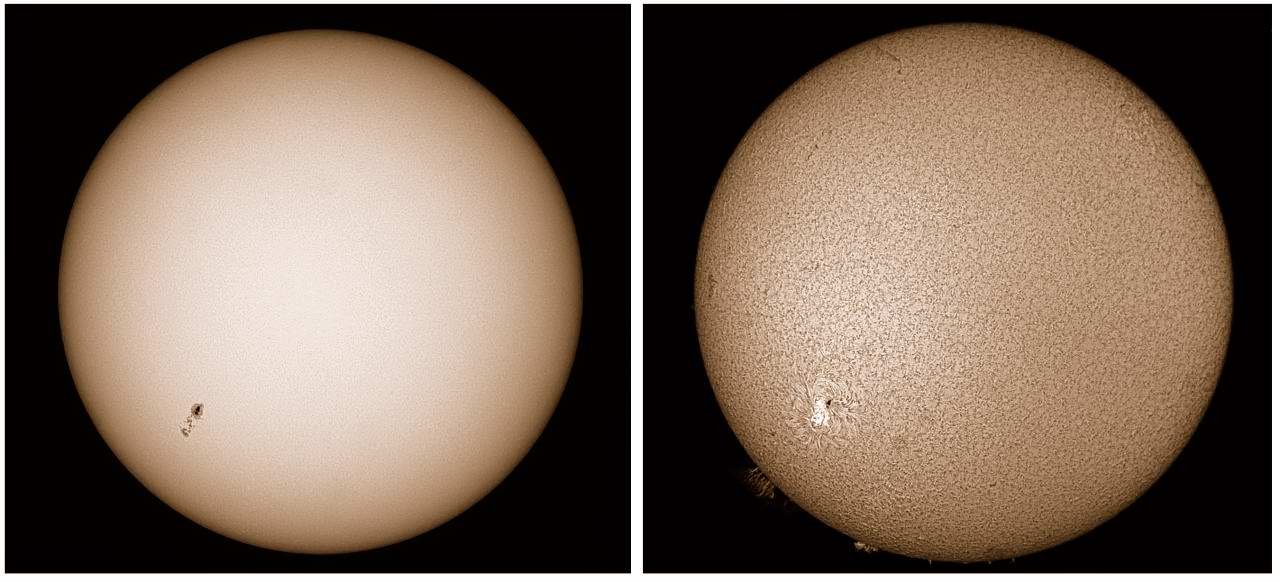 |
Left: Sun in a standard whitelight filter. Right: Sun in Hα |
The sun is composed primarily of hydrogen and that light has a wavelength of 6562.8Å (656 nm). The Hα filter only allows this frequency to be seen.
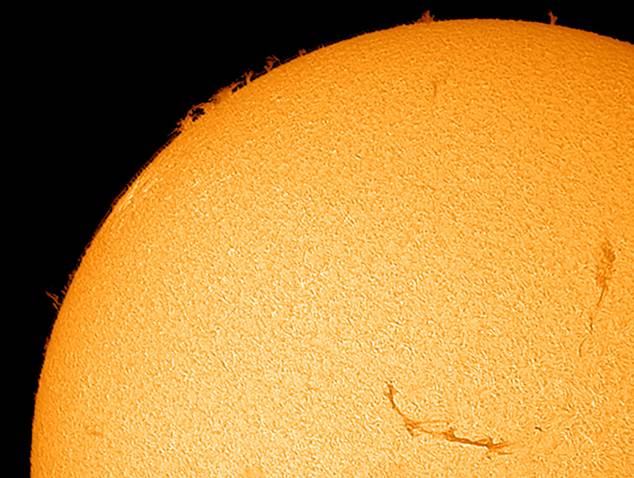 The most amazing thing a Hα filter reveals are the solar prominences. These are quite spurious as they crop up and disappear in often a very short
period of time. They can be small to very large, and they change rapidly. Before Hα filtering was available, the only way to see the
prominences was during a total solar eclipse.
The other feature often seen are the filaments which get their name because of their length. And you will always see the granulated
surface.
The most amazing thing a Hα filter reveals are the solar prominences. These are quite spurious as they crop up and disappear in often a very short
period of time. They can be small to very large, and they change rapidly. Before Hα filtering was available, the only way to see the
prominences was during a total solar eclipse.
The other feature often seen are the filaments which get their name because of their length. And you will always see the granulated
surface.
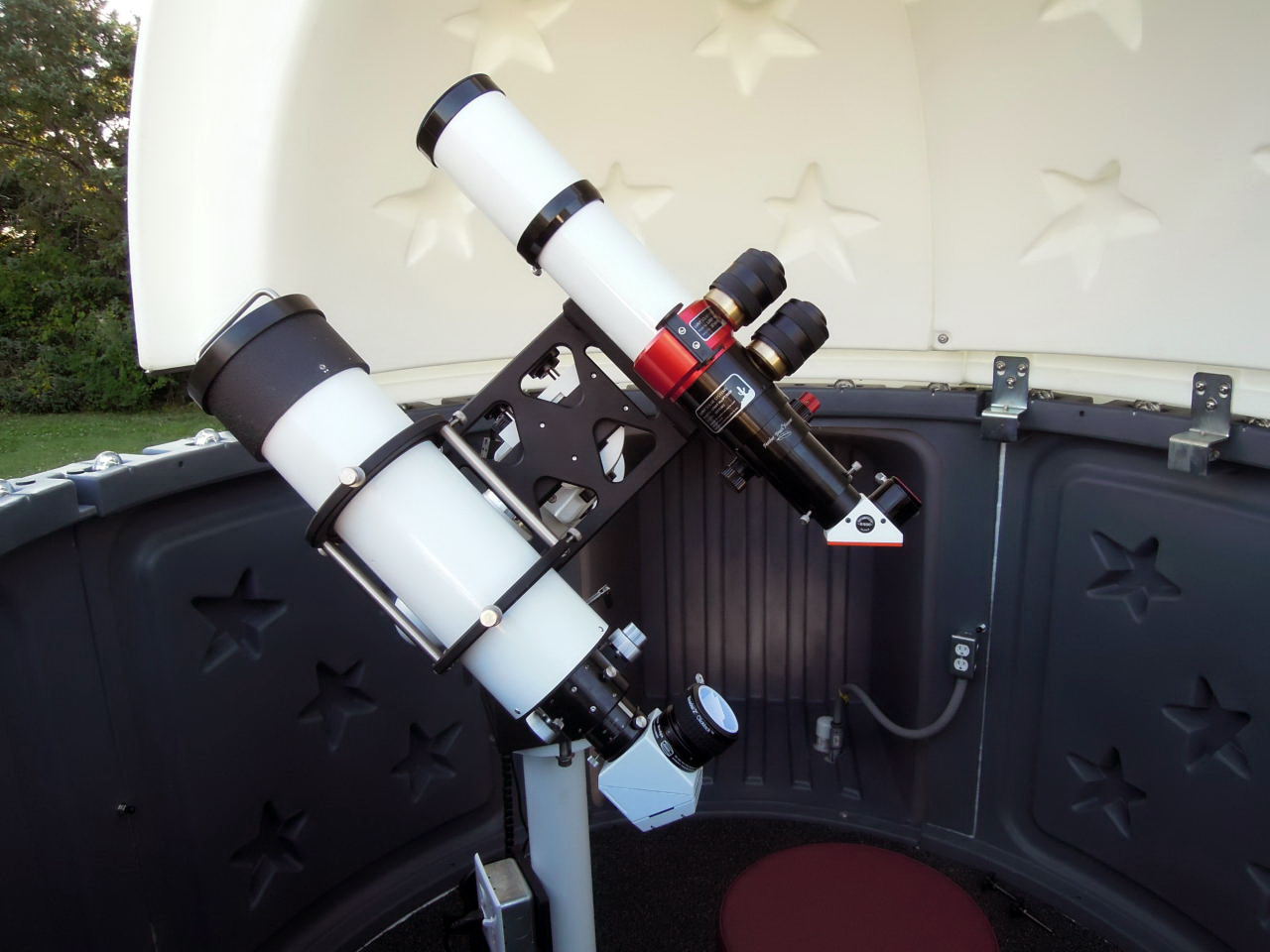 Though it is possible to use a Hydrogen Alpha filtering system with a standard telescope, a much better option is a dedicated Hα telescope. At the
Milwaukee Astronomical Society Observatory we have a dedicated
Solar Observatory with side by side mounted solar telescopes: one for standard whitelight
filtering and the other one a Hydrogen Alpha telescope.
Though it is possible to use a Hydrogen Alpha filtering system with a standard telescope, a much better option is a dedicated Hα telescope. At the
Milwaukee Astronomical Society Observatory we have a dedicated
Solar Observatory with side by side mounted solar telescopes: one for standard whitelight
filtering and the other one a Hydrogen Alpha telescope.
The MAS also have cameras so that images can be taken through the two telescopes. You can see many of our images of the sun here.
Solar Eclipses
We have an entire web page to discuss solar eclipses. Click/tap here to go to that page.

